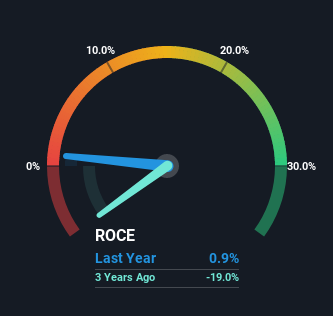Returns At Red Violet (NASDAQ:RDVT) Are On The Way Up
Finding a business that has the potential to grow substantially is not easy, but it is possible if we look at a few key financial metrics. Firstly, we'll want to see a proven return on capital employed (ROCE) that is increasing, and secondly, an expanding base of capital employed. Basically this means that a company has profitable initiatives that it can continue to reinvest in, which is a trait of a compounding machine. Speaking of which, we noticed some great changes in Red Violet's (NASDAQ:RDVT) returns on capital, so let's have a look.
What Is Return On Capital Employed (ROCE)?
For those who don't know, ROCE is a measure of a company's yearly pre-tax profit (its return), relative to the capital employed in the business. To calculate this metric for Red Violet, this is the formula:
Return on Capital Employed = Earnings Before Interest and Tax (EBIT) ÷ (Total Assets - Current Liabilities)
0.0094 = US$691k ÷ (US$77m - US$3.4m) (Based on the trailing twelve months to September 2022).
So, Red Violet has an ROCE of 0.9%. Ultimately, that's a low return and it under-performs the Professional Services industry average of 13%.
View our latest analysis for Red Violet
Historical performance is a great place to start when researching a stock so above you can see the gauge for Red Violet's ROCE against it's prior returns. If you want to delve into the historical earnings, revenue and cash flow of Red Violet, check out these free graphs here.
The Trend Of ROCE
We're delighted to see that Red Violet is reaping rewards from its investments and is now generating some pre-tax profits. The company was generating losses five years ago, but now it's earning 0.9% which is a sight for sore eyes. Not only that, but the company is utilizing 363% more capital than before, but that's to be expected from a company trying to break into profitability. This can tell us that the company has plenty of reinvestment opportunities that are able to generate higher returns.
In another part of our analysis, we noticed that the company's ratio of current liabilities to total assets decreased to 4.4%, which broadly means the business is relying less on its suppliers or short-term creditors to fund its operations. So this improvement in ROCE has come from the business' underlying economics, which is great to see.
The Key Takeaway
To the delight of most shareholders, Red Violet has now broken into profitability. And with a respectable 29% awarded to those who held the stock over the last three years, you could argue that these developments are starting to get the attention they deserve. Therefore, we think it would be worth your time to check if these trends are going to continue.
If you'd like to know about the risks facing Red Violet, we've discovered 2 warning signs that you should be aware of.
For those who like to invest in solid companies, check out this free list of companies with solid balance sheets and high returns on equity.
Have feedback on this article? Concerned about the content? Get in touch with us directly. Alternatively, email editorial-team (at) simplywallst.com.
This article by Simply Wall St is general in nature. We provide commentary based on historical data and analyst forecasts only using an unbiased methodology and our articles are not intended to be financial advice. It does not constitute a recommendation to buy or sell any stock, and does not take account of your objectives, or your financial situation. We aim to bring you long-term focused analysis driven by fundamental data. Note that our analysis may not factor in the latest price-sensitive company announcements or qualitative material. Simply Wall St has no position in any stocks mentioned.
Join A Paid User Research Session
You’ll receive a US$30 Amazon Gift card for 1 hour of your time while helping us build better investing tools for the individual investors like yourself. Sign up here


